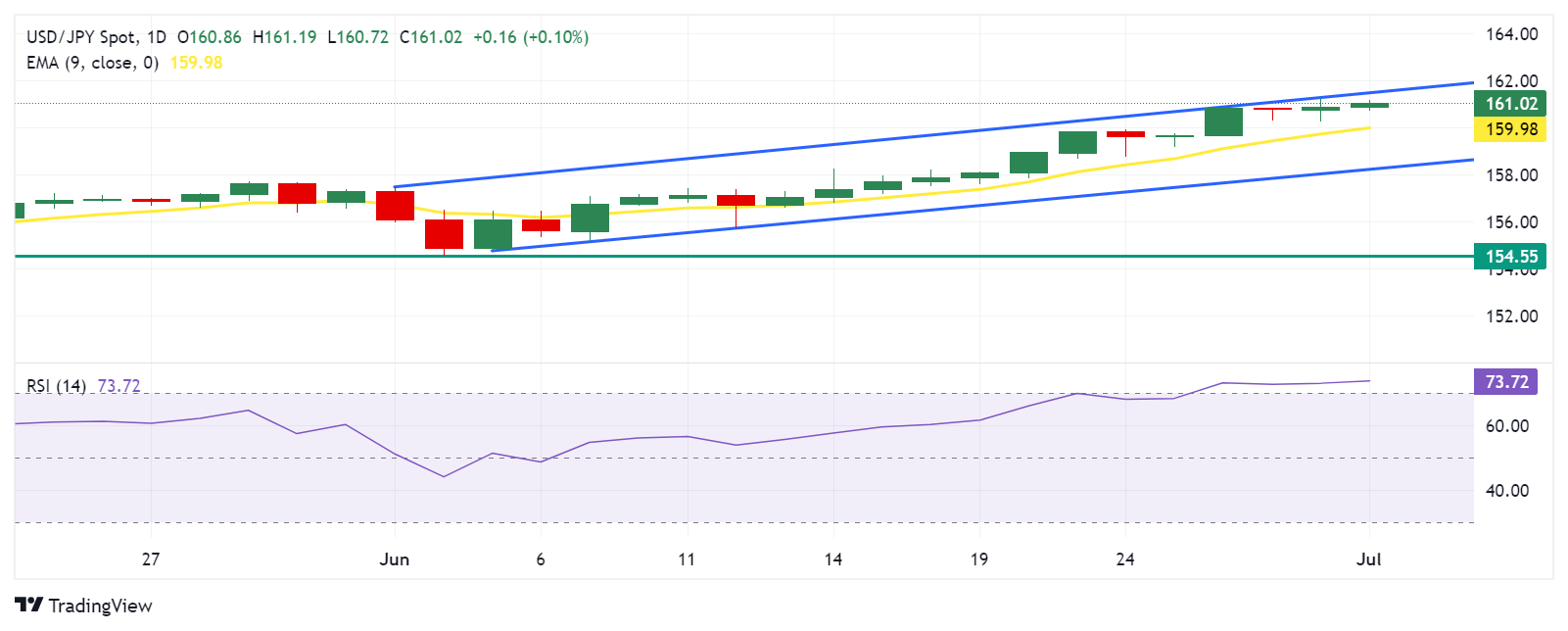- The Japanese Yen holds ground around its 38-year low of 161.28.
- The JPY may limit its downside as the Tankan Large Manufacturing Index rose to 13 in Q2, hitting the highest level in two years.
- The US Dollar struggles as recent inflation data raise expectations of Fed rate cuts in 2024.
The Japanese Yen (JPY) holds ground on Monday near its lowest level of 161.28 since 1986. The JPY may appreciate as an upbeat Japan’s business confidence data lifts market sentiment. Additionally, the expected speculations about an imminent intervention by Japanese authorities support the JPY and limit the upside of the USD/JPY pair.
Japan’s Tankan Large Manufacturing Index rose to 13 in the second quarter from the previous reading of 11. The index hit the highest level in two years amid an improving economic outlook. Meanwhile, Japan’s Jibun Bank Manufacturing PMI for June was revised slightly lower to 50 from a preliminary reading of 50.1 but remained expansionary for the second straight month.
The US Dollar (USD) depreciates as recent inflation data raises expectations of the US Federal Reserve’s (Fed) deducting interest rates in 2024. The CME FedWatch Tool indicates that the likelihood of a Fed rate cut in December by 25 basis points has increased to nearly 32.0%, up from 28.7% a week earlier.
Daily Digest Market Movers: Japanese Yen declines despite upbeat business confidence data
- Japan’s Tankan Large Manufacturing Outlook rose to 14 in the second quarter from the previous reading of 10. Meanwhile, Large All Industry Capex increased to 11.1% in the second quarter from the previous 4.0% reading.
- On Friday, the Federal Reserve Bank of San Francisco President Mary Daly said that monetary policy is working. Still, it’s too early to tell when it will be appropriate to cut the interest rate. Daly stated, "If inflation stays sticky or comes down slowly, rates would need to be higher for longer,” per Reuters.
- On Friday, the US Bureau of Economic Analysis reported that US inflation eased to its lowest annual rate in over three years. The US Personal Consumption Expenditures (PCE) Price Index increased by 2.6% year-over-year in May, down from 2.7% in April, meeting market expectations. Core PCE inflation also rose by 2.6% year-over-year in May, down from 2.8% in April, aligning with estimates.
- Reuters reported on Friday that Japanese Finance Minister Shunichi Suzuki said that the authorities were "deeply concerned" about the impact of "rapid and one-sided" foreign exchange moves on the economy. Suzuki added that excessive volatility in the currency market is undesirable and that authorities will respond appropriately to such moves.
- On Friday, the data showed that Consumer Price Index (CPI) inflation in Tokyo rose to 2.3% year-over-year in June, up from the previous period's 2.2%. Core Tokyo CPI inflation, which excludes volatile food prices, also increased during the same period, reaching 2.1% YoY compared to the previous 1.9%, surpassing the median market forecast of 2.0% YoY.
Technical Analysis: USD/JPY hovers around 161.00
USD/JPY trades around 161.00 on Monday. The analysis of the daily chart shows a bullish bias, with the pair hovering near the upper boundary of an ascending channel pattern. The 14-day Relative Strength Index (RSI) is positioned above the 50 level, indicating upward momentum.
Surpassing the upper boundary of the ascending channel pattern around 161.50 will reinforce the bullish sentiment, potentially driving the USD/JPY pair toward the psychological level of 162.00.
On the downside, immediate support appears at the nine-day Exponential Moving Average (EMA) at 159.98. A breach below this level could intensify downward pressure on the USD/JPY pair, potentially driving it toward the lower boundary of the ascending channel around 158.20. A break below this level could push the pair to test June’s low at 154.55.
USD/JPY: Daily Chart
Japanese Yen PRICE Today
The table below shows the percentage change of Japanese Yen (JPY) against listed major currencies today. Japanese Yen was the weakest against the Euro.
| USD | EUR | GBP | JPY | CAD | AUD | NZD | CHF | |
|---|---|---|---|---|---|---|---|---|
| USD | -0.38% | -0.15% | 0.18% | 0.03% | -0.09% | -0.06% | 0.23% | |
| EUR | 0.38% | 0.00% | 0.28% | 0.10% | 0.17% | 0.02% | 0.31% | |
| GBP | 0.15% | -0.01% | 0.24% | 0.13% | 0.17% | 0.01% | 0.30% | |
| JPY | -0.18% | -0.28% | -0.24% | -0.15% | -0.21% | -0.24% | 0.07% | |
| CAD | -0.03% | -0.10% | -0.13% | 0.15% | -0.09% | -0.09% | 0.20% | |
| AUD | 0.09% | -0.17% | -0.17% | 0.21% | 0.09% | -0.16% | 0.21% | |
| NZD | 0.06% | -0.02% | -0.01% | 0.24% | 0.09% | 0.16% | 0.31% | |
| CHF | -0.23% | -0.31% | -0.30% | -0.07% | -0.20% | -0.21% | -0.31% |
The heat map shows percentage changes of major currencies against each other. The base currency is picked from the left column, while the quote currency is picked from the top row. For example, if you pick the Japanese Yen from the left column and move along the horizontal line to the US Dollar, the percentage change displayed in the box will represent JPY (base)/USD (quote).
Economic Indicator
Jibun Bank Services PMI
The Services Purchasing Managers Index (PMI), released on a monthly basis by Jibun Bank and S&P Global, is a leading indicator gauging business activity in Japan’s services sector. As the services sector dominates a large part of total GDP, the services PMI is an important indicator of the overall economic conditions in Japan. The data is derived from surveys of senior executives at private-sector companies from the services sector. Survey responses reflect the change, if any, in the current month compared to the previous month and can anticipate changing trends in official data series such as Gross Domestic Product (GDP), employment and inflation. A reading above 50 indicates that the services economy is generally expanding, a bullish sign for the Japanese Yen (JPY). Meanwhile, a reading below 50 signals that activity among service providers is generally declining, which is seen as bearish for JPY.
Read more.Next release: Wed Jul 03, 2024 00:30
Frequency: Monthly
Consensus: 49.8
Previous: 49.8
Source: S&P Global
Information on these pages contains forward-looking statements that involve risks and uncertainties. Markets and instruments profiled on this page are for informational purposes only and should not in any way come across as a recommendation to buy or sell in these assets. You should do your own thorough research before making any investment decisions. FXStreet does not in any way guarantee that this information is free from mistakes, errors, or material misstatements. It also does not guarantee that this information is of a timely nature. Investing in Open Markets involves a great deal of risk, including the loss of all or a portion of your investment, as well as emotional distress. All risks, losses and costs associated with investing, including total loss of principal, are your responsibility. The views and opinions expressed in this article are those of the authors and do not necessarily reflect the official policy or position of FXStreet nor its advertisers. The author will not be held responsible for information that is found at the end of links posted on this page.
If not otherwise explicitly mentioned in the body of the article, at the time of writing, the author has no position in any stock mentioned in this article and no business relationship with any company mentioned. The author has not received compensation for writing this article, other than from FXStreet.
FXStreet and the author do not provide personalized recommendations. The author makes no representations as to the accuracy, completeness, or suitability of this information. FXStreet and the author will not be liable for any errors, omissions or any losses, injuries or damages arising from this information and its display or use. Errors and omissions excepted.
The author and FXStreet are not registered investment advisors and nothing in this article is intended to be investment advice.
Recommended content
Editors’ Picks

EUR/USD: The path of least resistance is to the downside near 1.0300
The EUR/USD pair weakens to near 1.0315 during the early European session on Monday. The expectation that the European Central Bank will further cut the interest rate this year undermines the Euro against the Greenback.

GBP/USD holds steady above 1.2400; upside potential seems limited amid bullish USD
The GBP/USD pair struggles to capitalize on Friday's modest recovery gains and oscillates in a range, above the 1.2400 mark at the start of a new week. Spot prices, meanwhile, remain close to the lowest level since April 2024 touched last week and seem vulnerable to prolonging over a three-month-old downtrend on the back of a bullish US Dollar.

Gold price moves away from multi-week high on hawkish Fed expectations
Gold price turned lower for the second straight day on Monday, though the downside seems limited. The Fed’s hawkish signal remains supportive of elevated US bond yields and exerts some pressure. Geopolitical risks and trade war fears might continue to offer support to the safe-haven XAU/USD.

Bitcoin, Ethereum and Ripple show signs of bullish momentum
Bitcoin’s price is approaching its key psychological level of $100,000; a firm close above would signal the continuation of the ongoing rally. Ethereum price closes above its upper consolidation level of $3,522, suggesting bullish momentum. While Ripple price trades within a symmetrical triangle on Monday.

Week ahead – US NFP to test the markets, Eurozone CPI data also in focus
King Dollar flexes its muscles ahead of Friday’s NFP. Eurozone flash CPI numbers awaited as euro bleeds. Canada’s jobs data to impact bets of a January BoC cut. Australia’s CPI and Japan’s wages also on tap.

Best Forex Brokers with Low Spreads
VERIFIED Low spreads are crucial for reducing trading costs. Explore top Forex brokers offering competitive spreads and high leverage. Compare options for EUR/USD, GBP/USD, USD/JPY, and Gold.
